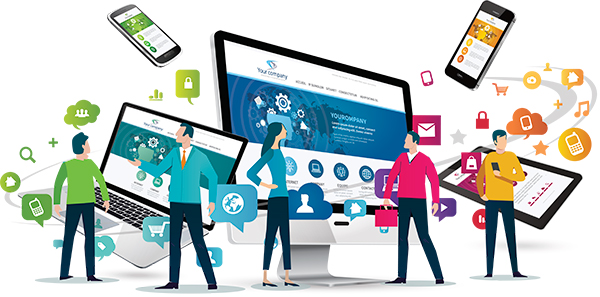
Embracing the New Normal
Using digital patient engagement solutions to collect balances and improve customer satisfaction.
By Joseph Favata

The last decade has seen a seismic shift in the healthcare industry. Healthcare consumer expectations have changed, as has their relationship with the industry. Healthcare consumers want to manage their healthcare business online, and they expect a one-stop “Amazon-like” experience.
At the same time, there was a shift in payment responsibility from insurance to patients, which made it more challenging for providers to recover net revenue. Plus, many providers have fallen behind the technology curve and are unprepared to provide the seamless, online convenience consumers want.
Fortunately, there is a solution. Providers can onboard a digital engagement solution that provides patients with an all-in-one financial experience and significantly enhances recovery rates and increases cash flow. One provider that integrated such a solution saw improved contact and payment rates that exceeded their average recovery by 20% within the first few months.
The Challenge
Shifting Consumer Expectations
Patients have started to shop around for healthcare. They search for the best price,1 but they’re also seeking out the best financial experience.2 Specifically, they’re looking for the same experience from healthcare providers that they receive from companies outside the healthcare market. According to research findings by NTT DATA Services, 59% of consumers expect the digital healthcare experience to emulate their favorite online retail experiences, like those provided by Apple, Amazon, and Google.3
When it comes to their healthcare financial experience, they want an all-in-one platform that allows them to communicate, pay bills, and manage financial matters using mobile phones, personal computers, and tablets. They want a seamless experience, intuitive interactions, instant answers, and the flexibility to conduct business at times convenient for them.4
Patients have become consumers, slowly transforming the healthcare industry into a consumer-driven market. Unfortunately, the healthcare industry has fallen behind when it comes to what consumers want most: exceptional digital experiences. A recent survey found that healthcare providers are significantly behind other industries when it comes to technology. For example, only 18% of large hospitals and 6% of smaller hospitals have automated their corporate services functions.5
Barriers to Collect
Changes in the healthcare system have altered the relationship between patients and the healthcare industry. A decade ago, providers worked chiefly with health insurance companies to recover payments. Now, patients are the third-largest payer behind Medicare and Medicaid.6
And although patient co-pays and deductibles have been increasing between 6% and 8% year after year, providers are not the beneficiaries of those rising numbers.7 On the contrary, higher deductibles have led to more medical debt for consumers.8 The result for providers is slower payments and unpaid bills. In fact, 70% of providers indicate that it takes more than a month to collect from patients,9 and nearly one-quarter of working-age adults have past-due medical debt.10
Furthermore, collecting payments from patients is more expensive and requires more time than collecting from insurance.11 Therefore, providers have had to hire more billing staff and augment their tools to educate consumers about healthcare finances.
At the same time, the efficacy of traditional collection tactics (letters, phone calls) has decreased. Caller ID helps individuals screen calls and decide which callers they elect to talk with. Plus, the sheer volume of marketing robocalls has made individuals hesitant to answer their phone.
The challenges described above have made it harder for hospitals and healthcare systems to stay afloat and satisfy their patients.
Advertisement. Click on image to visit advertiser's website. Story continues below.

|
The Perspective
The Experience of a Typical Healthcare Provider
The following experience of one provider offers a snapshot of a typical situation and the opportunity available to all healthcare providers. Jackson Hospital is a $1B not-for-profit, independently governed, acute care hospital in a rural, blue-collar region populated by non-affluent individuals. Their patients have an average credit score of under 600, and their population distribution includes 56% Medicare, 11% Medicaid, and 6% self-pay.
The Situation
In 2019, David Ralston, assistant vice president of revenue cycle at Jackson Hospital, realized they were 10-15 years behind in revenue cycle processes and technology. They didn’t have patient-friendly statements or a robust patient engagement process, and they were falling short of the industry standard for best practices in the patient billing process. Additionally, Jackson Hospital’s cash collections were not meeting goal.
The Vision
When David and his team analyzed their situation and considered how the healthcare industry had evolved, they realized it was time to make a significant change in their revenue cycle processes and technology. Their circumstance was dire, and this was their opportunity to improve the quality of service provided while also establishing a more efficient collections process.
To that end, they had two strategic goals:
- David wanted to become a true service center. They wanted to be the provider of choice for their community by offering an efficient, high-tech collections process, and improved communication contacts and patient engagement.
- David needed to improve their cash flow and
revenue cycle.
David and his team concluded that they needed a digital patient engagement solution, and they chose M GAGEMENT by MedAssist.
The Results
By integrating M GAGEMENT into their financial services process, Jackson Hospital realized all of their goals, achieving an elevated, full-service financial experience for patients and improving patient-liability recoveries, reducing bad debt expense, and lowering collections expense. Significantly, they saw contact and payment rates that exceeded their average recovery by 20% within the first few months.
The Solution
Providers can elect to onboard a digital patient engagement solution that will give patients the experience they’re looking for while also optimizing the payment collection process.
M GAGEMENT is a seamless, one-stop portal with the look, feel, and ease offered by the best consumer-centric websites. It is a secure website, branded for each hospital, that is compatible with all EHR systems. It gives patients the intuitive experience they are looking for and enables them to conduct all of their healthcare finance business from their personal devices, whenever they want.
M GAGEMENT provides patients with comprehensive financial services capabilities, including the following:
It helps increase payment rates because it gives patients a convenient, easy-to-use portal for making payments. But it is also a data-driven solution that uses intelligent analytics, powered by propensity-to-pay scoring models, machine learning, and AI to maximize and enhance opportunities for patient interaction and payment options and help achieve next-level successes.
- Optimize ability to pay – Creates a customized payment program for each patient based on attributes and data elements specific to each individual. Uses statistics to understand the patient population and determine the likelihood of repayment.
- Uncover undiscovered funding sources – Applies advanced data analytics to individual cases to identify signs that there may be undiscovered opportunities for funding, such as third-party liability, workers compensation, and disability.
- Enhance engagement and improve contact rate – Uses algorithms to continually fine-tune communication strategies, which include over 100 proactive and reactive messages tailored to specific patient activity. Analyzes collected data to understand the patient population (e.g., when to reach patients, how to reach patients, etc.) to determine how best to maximize patient engagement and increase cash recoveries.
- Improve customer satisfaction – Continually learns what actions result in the highest patient satisfaction and determines which offerings and communication strategies work best for each patient.
Future State
Over the past decade, healthcare consumer expectations and responsibilities have evolved, and so has technology. And there’s every reason to believe that those developments are here to stay. In their vision for the future of health in 2040, Deloitte leaders envisaged “a world in which technology use accelerates, useful and actionable data flows easily, and the use of tools to maintain well-being will be widespread.12
Forward-thinking healthcare providers that recognize today’s reality and understand the limitations of their current processes have the opportunity to become industry leaders in the next decades. By aligning their financial services engagement strategy with patient expectations, they can create a satisfied and loyal customer base and enhance their ability to care for communities long into the future, all while optimizing their ability to recover net revenue.
Joseph Favata is the head of field marketing for provider healthcare at MedAssist. He can be reached at joseph.favata@gomedassist.com
Resources
1 “A consumer-centered future of health” (Nov 2019) https://www2.deloitte.com/us/en/insights/industry/health-care/global-health-care-trends-survey.html; “Today’s Consumers Reveal the Future of Healthcare,” Accenture 2019 Digital Health Consumer Survey, US Results, p.13
2 “Inside the patient journey: Three key touch points for consumer engagement strategies” (Sep 2018) https://www2.deloitte.com/us/en/insights/industry/health-care/patient-engagement-health-care-consumer-survey.html
3 “NTT DATA Study Finds Nearly Two-Thirds of Consumers Expect Their Healthcare Digital Experience to be More Like Retail, NTT Data Services (Mar 2018)
https://us.nttdata.com/en/news/press-release/2018/ march/ntt-data-study-finds-consumers-expect-their-healthcare-digital-experience-to-be-like-retail
4 “Report: Patients’ out-of-pocket costs increased,” https://www.modernhealthcare.com/patients/report-patients-out-pocket-costs-increased-up-14-2018
5 “Survey: Hospitals overspending on corporate services could reduce costs without impacting quality,” Research & Reports | Healthcare Business Trends, Sponsored by Navigant, A Guidehouse Company (Apr 2020), p. 4; The survey understands “corporate services” to include administration, finance, IT, human relations, supply chain, revenue cycle, marketing, facilities, real estate and plant operations (pp. 1-2).
6 “Intermountain, Geisinger shift focus,” https://www.healthcaredive.com/news/intermountain-geisinger-shift-focus-to-patients-in-revenue-cycle/515484/
7 “Report: Patients’ out-of-pocket costs increased,” https://www.modernhealthcare.com/patients/report-patients-out-pocket-costs-increased-up-14-2018
8 Jennifer Rubin, “Just how big is Trump’s health-care mistake?” (Apr 2019)
https://www.washingtonpost.com/opinions/2019/04/03/ just-how-big-is-trumps-healthcare-mistake/
9 “Intermountain, Geisinger shift focus,” https://www.healthcaredive.com/news/intermountain-geisinger-shift-focus-to-patients-in-revenue-cycle/515484/
10 M. Karpman and KJ Caswell, “Past-due medical debt among nonelderly adults, 2012–2015,” Urban Institute (Mar 2017) http://apps.urban.org/features/medical-debt-in-america/
11 “Intermountain, Geisinger shift focus,” https://www.healthcaredive.com/news/intermountain-geisinger-shift-focus-to-patients-in-revenue-cycle/515484/
12 “A consumer-centered future,”
https://www2.deloitte.com/us/en/insights/industry/health-care/global-health-care-trends-survey.html; see also, Deloitte Insights, “Health Care Current—December 10, 2019,” https://www2.deloitte.com/us/en/blog/health-care-blog/2019/year-of-consumer.html
|


